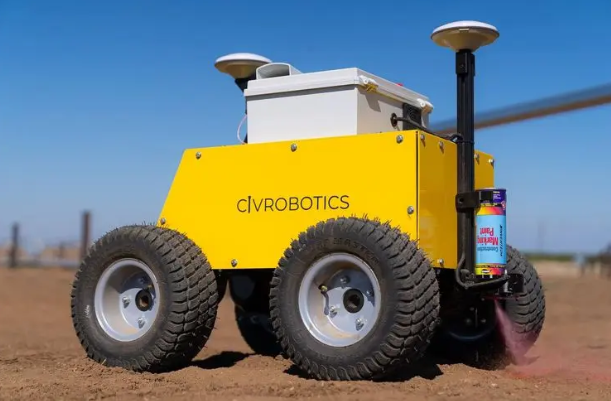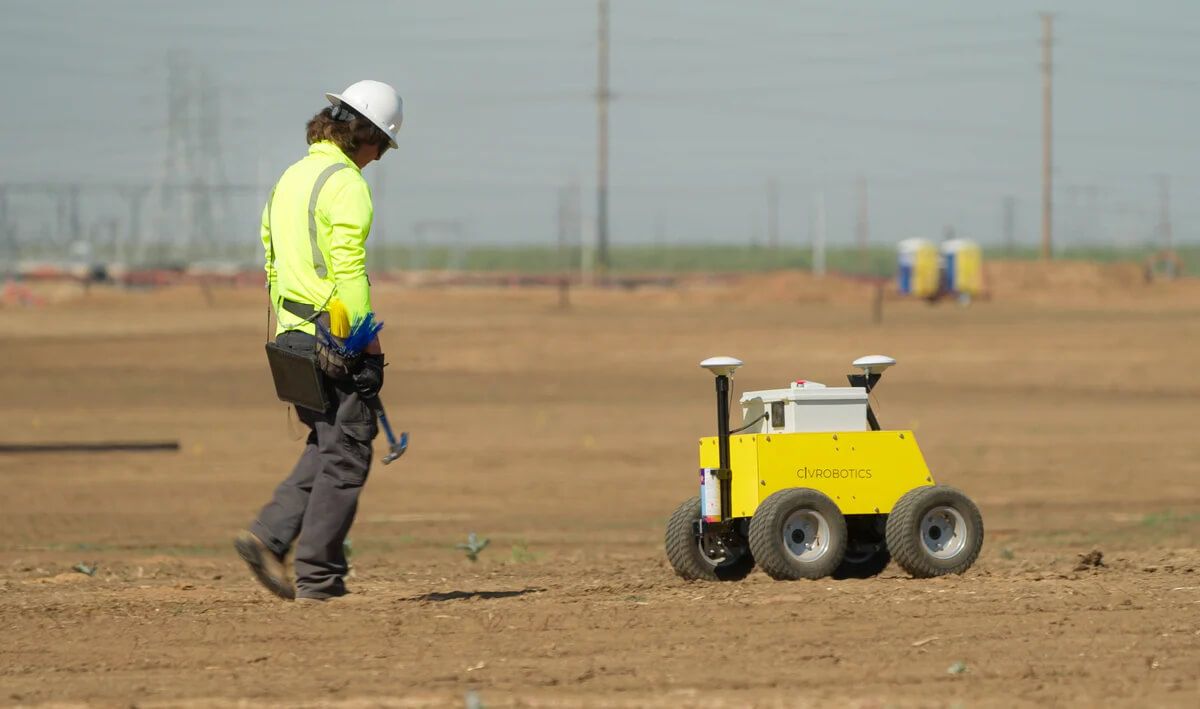Civ Robotics has emerged as a transformative force in the construction industry, leveraging cutting-edge autonomous technology to redefine how site layouts are performed. Their flagship products, CivDot and CivDot+, are autonomous surveying robots designed to improve precision, efficiency, and safety in construction projects. This case study explores the technical aspects of these robots, their impact on the industry, and the reasoning behind their adoption.
Challenges in Traditional Construction Layouts
The traditional approach to construction layout relies heavily on manual surveying techniques, which demand a high level of expertise and are susceptible to human error. This method involves physically measuring and marking points on the construction site to translate two-dimensional blueprints into a three-dimensional space. The process is time-consuming and labor-intensive, often requiring multiple workers to complete. Moreover, the accuracy of these manual measurements can be affected by various factors such as uneven terrain, weather conditions, and human fatigue, leading to discrepancies between the intended design and the actual layout on the ground.
These discrepancies can have far-reaching consequences for construction projects. When the physical layout does not align with the blueprints, it can trigger a cascade of issues throughout the construction process. Structural elements may not fit as intended, mechanical and electrical systems may require modifications, and finishing work may be compromised. These problems often necessitate rework, causing project delays and budget overruns. Furthermore, the construction industry is facing increasing challenges due to skilled labor shortages and stringent safety regulations. The need for experienced surveyors and the risks associated with working in hazardous site conditions further compound the inefficiencies inherent in traditional layout methods, highlighting the urgent need for more advanced, automated solutions in construction layout processes.
Technical Overview of Civ Robotics’ Solutions
1. CivDot and CivDot+: Autonomous Layout Robots
CivDot and CivDot+ are rugged 4WD ground rovers designed for autonomous navigation in challenging terrains and harsh climates. These advanced robots excel at marking coordinates with high precision, significantly outperforming traditional surveying methods. Their impressive capabilities include marking up to 3,000 coordinates per day, which is eight times faster than manual techniques. The rovers achieve remarkable accuracy within 3/100′ (8 mm) by utilizing dual-RTK GNSS receivers and IMU-based tilt correction. To handle rough terrains such as mud or sand, they feature a 10″ ground clearance. Safety is enhanced through remote operation from up to 100 feet away, minimizing risks to personnel. These features make CivDot and CivDot+ highly efficient and reliable tools for surveying and mapping in various challenging environments.
2. Integration with GNSS Technology
Both models utilize cutting-edge Global Navigation Satellite System (GNSS) technology to implement real-time kinematic (RTK) corrections, significantly enhancing positioning accuracy to centimeter-level precision. This advanced system continuously processes satellite signals and corrects for various atmospheric and environmental factors that can affect signal propagation. By employing a network of fixed ground-based reference stations, RTK technology can provide instantaneous position updates with exceptional accuracy.
The integration of RTK corrections in these models represents a substantial improvement over traditional GPS systems, which typically offer accuracy within several meters. This enhanced precision eliminates the need for time-consuming manual validation of GPS readings, streamlining operations and reducing the potential for human error. As a result, these models can be deployed in applications requiring high-precision positioning, such as precision agriculture, surveying, and autonomous vehicle navigation, with increased reliability and efficiency.
3. CivPlan Software
CivPlan is pre-installed software designed to streamline mission planning and field operations. Users can easily upload coordinate files in CSV or DXF formats, allowing the software to optimize routes efficiently. The robot then operates autonomously, marking points using various methods such as spray paint, laser pointers, or physical markers like stakes. One of CivPlan’s key features is its real-time reporting capability, which provides users with comprehensive data on marked coordinates, timestamps, and tolerance levels. This functionality enables users to monitor progress and ensure accuracy throughout the operation, making CivPlan an invaluable tool for professionals in fields requiring precise geospatial marking and data collection.

Real-World Applications
1. Solar Farms
Bechtel Corporation adopted CivDot for surveying solar projects. The robot enabled them to mark 1,250 coordinates daily, six times faster than manual methods, reducing labor costs and expediting project timelines while maintaining high accuracy.
2. Infrastructure Projects
Civ Robotics’ solutions have been deployed across various infrastructure projects such as roadways, power plants, and industrial developments. Their ability to handle large-scale layouts efficiently makes them ideal for complex projects requiring tight tolerances.
3. Diverse Terrain Adaptability
The robots’ robust design allows them to operate seamlessly in extreme climates and challenging terrains like sand dunes or muddy construction sites. This adaptability ensures consistent performance across diverse project environments.
Impact on the Industry
Civ Robotics is tackling significant challenges in the construction sector through innovative automation solutions. The company’s robotic systems address the persistent issue of labor shortages by automating layout tasks, reducing the need for large crews and allowing contractors to allocate human resources more efficiently. These robots significantly enhance the speed of marking processes, enabling construction teams to meet tight project deadlines and improve overall productivity.The high precision of Civ Robotics’ automated systems minimizes costly errors during construction, ensuring greater accuracy in building processes and potentially reducing rework and material waste.
Furthermore, the remote operation capabilities of these robots enhance worker safety by reducing exposure to hazardous conditions on construction sites. This technological advancement aligns seamlessly with Industry 4.0 principles, integrating sophisticated automation into traditional construction workflows. By doing so, Civ Robotics not only streamlines operations but also empowers workers to focus on higher-value tasks, potentially upskilling the workforce and improving job satisfaction. The company’s approach demonstrates how automation can complement human expertise in the construction industry, driving efficiency, safety, and quality improvements while addressing longstanding challenges in the sector.
Conclusion
Civ Robotics has set a new benchmark for construction layout efficiency with its autonomous surveying robots. By combining advanced GNSS technology with user-friendly software like CivPlan, these robots empower professionals to achieve precision and speed that were previously unattainable through manual methods. Whether it’s marking thousands of coordinates in a solar farm or navigating rugged terrains for infrastructure projects, Civ Robotics is paving the way for smarter construction practices worldwide.
Their solutions not only address current industry challenges but also promise long-term benefits through reduced costs, enhanced safety, and improved project outcomes, marking a significant leap toward automation-driven construction innovation.
Reference
- Bechtel Corporation. Bechtel and Civ Robotics partnership for solar farm construction. Retrieved from https://www.bechtel.com
- Civ Robotics. CivDot: Autonomous layout robot for construction. Retrieved from https://www.civrobotics.com
- Civ Robotics. CivPlan software: Simplifying construction layout workflows. Retrieved from https://www.civrobotics.com/civplan
- Industry 4.0 in Construction. (2023). Automation and robotics in construction: Trends and innovations. Journal of Construction Technology, 12(3), 45–60.
- Smith, J. (2022). The impact of autonomous robots on construction safety and efficiency. Construction Automation Review, 18(2), 78–92.

